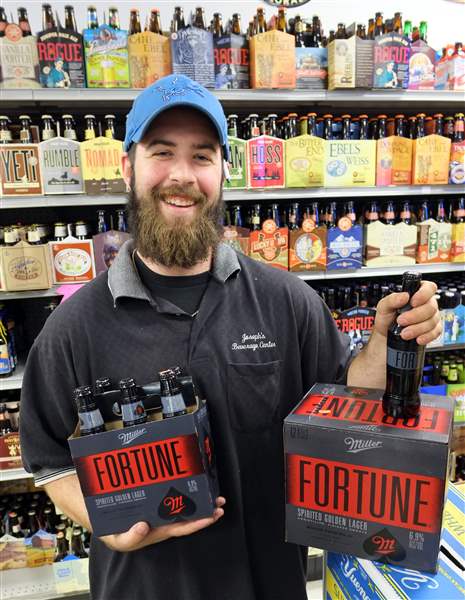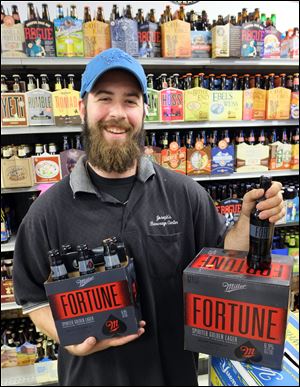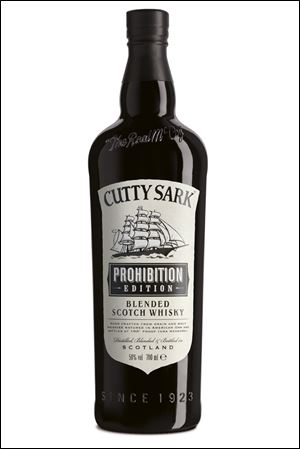
Owens-Illinois says its black glass bottles are becoming its new green
Firm boosts production as distilleries thirst for color
6/8/2014
Joe Fisher of Joseph’s Beverage Center, shows Miller Fortune’s bottling. MillerCoors says the packaging has prompted consumers to say ‘no other beer looks like Miller Fortune.’
THE BLADE/JEREMY WADSWORTH
Buy This Image

Joe Fisher of Joseph’s Beverage Center, shows Miller Fortune’s bottling. MillerCoors says the packaging has prompted consumers to say ‘no other beer looks like Miller Fortune.’
New York fashion experts agree that when it comes to clothing, blue is the new black.
But in the world of glass bottles, it appears that the new black is ... black.
Owens-Illinois Inc., which four years ago began experimenting with more cost-effective ways to make a variety of colored glass, has discovered that beer, wine, and distilled spirits-makers have taken a shine to black glass made by the Perrysburg company.
As a result, the glass-packaging maker has been beefing up its black-glass production capabilities worldwide to meet increased customer demand.
“There continues to be great enthusiasm around the capabilities we have created in our new innovation center. In the first quarter alone, we produced samples of more than 20 newly designed concepts for customers for wine, beer, and nonalcoholic beverages, highlighting the strong collaboration between our global-product innovation team and the research-and-development team,” O-I Chairman and CEO Al Stroucken told Wall Street analysts in late April when the company reported its first-quarter earnings.
In mid-April, O-I announced that it plans to spend more than $40 million to upgrade its plant in Alloa, Scotland, specifically to supply customers in the Scottish whisky business.
High on the list of products to be produced in Alloa: black glass bottles for a number of distilled spirits customers.
Lisa Babington, an O-I spokesman, said black glass isn’t a novelty product.
“It represents another choice we offer to our customers, and it’s growing in popularity. We expect it to gain in significance as the trend toward premiumization continues, however it is not a significant part of today's sales figures,” Ms. Babington said.
In the first quarter of 2014, O-I produced samples of 19 newly designed black glass concepts for customers producing wine, beer, distilled spirits, and nonalcoholic beverages, said Rildo Lima, who is O-I’s vice president and general manager for global specialties and global innovation as well as the company’s acting chief commercial officer.
Mr. Lima said that in 2010, when O-I started looking for better ways to protect the contents inside the bottles it makes, it began investigating a variety of new colors.
Black showed a lot of promise for two reasons.

Cutty Sark uses O-I’s black glass for its new Prohibition Edition blended scotch.
“No. 1, there was the aesthetic factor. It projects a premium image,” Mr. Lima said. “No. 2, could it provide better UV protection, that is, the same or better than amber?”
Mr. Lima said the answer to second question was yes, but O-I already could produce clear glass with adequate protection from ultra-violet rays.
The real question, he said, was whether O-I customers would see a premium value in using black glass. The answer, it turns out, was a resounding yes.
“Four years ago it was just two or three products, now we’re at 19 products,” Mr. Lima said.
One customer that has embraced black glass is MillerCoors brewing company, which is using O-I’s jet black bottles for its new Miller Fortune premium beer.
“Miller Fortune was developed to compete in spirits drinking occasions, and we wanted to design the packaging to be unique, sleek, and different from other beers. Black glass was preferred by consumers and was one of the visual icons to help launch Miller Fortune,” said Ben Feeney, marketing manager for branded innovations at MillerCoors.
Mr. Feeney said that with its black glass bottle, response to Miller Fortune “has been exceptional. Consumers have said that no other beer brand looks like Miller Fortune.”
Shawn Welch, vice president of sales and marketing for O-I North America, said the positive reaction to Miller Fortune was exactly why O-I began experimenting with new colors for its glass packaging, and why it believes black glass has a huge untapped potential.
Lots of potential
“MillerCoors wanted innovation around their new product. So what would make this product different?” Mr. Welch said.
“Color differentiation is one of those ideas where, if you look at a beer bottle, you see a lot of amber-colored beer bottles, you see some clear bottles, but you don’t see a lot of color differentiation.
“So when blue shows up, you notice that, like with Bud Light Platinum,” Mr. Welch said of Anheuser-Busch’s cobalt bottle.
“MillersCoors was looking to position this new beer, which has a higher alcohol content, and they wanted to make it look different on the shelf,” Mr. Welch said. “So we started to explore ways to process that and make that appearance stand out. It started with a normal stock bottle and then we said, ‘Why not make it appear black in color?’
“And with that we started to deal with shape differentiation to make it even more distinctive in the consumer’s mind when it is sitting on the shelf and in bars.”
Mr. Welch said a big selling point for O-I’s black glass is that it is “authentic,” that is, the glass is inherently black. Other black bottles in use start as clear glass with a black glass treatment or black sheet that covers it.
“If you break our glass, it will be black throughout,” Mr. Welch said.
How it is done
O-I officials declined to say how they make black glass.
But in general, glass can be made in various colors by adding various metals or chemical compounds during the glass-making process.
Mr. Feeney of MillerCoors said the solid black color assured the brewer that light will not penetrate the bottle and degrade the beer.
“Too much light or heat can change the way beer tastes or ‘skunk’ the taste,” Mr. Feeney said.
“Miller Fortune’s black bottle not only provides a unique design aesthetic, it keeps light out so the rich taste and smooth finish of the golden lager can come through consistently,” Mr. Feeney said.
Owens-Illinois has been able to make black glass for a long time. But without demand, it was expensive.
Mr. Lima said once O-I mastered the basics to produce the correct color, the company was able to gain production cost-efficiencies.
“We now have many facilities that are able to make black glass. We can make it In Brazil and Australia, New York and Atlanta, and Ottawa [Canada] and Scotland,” Mr. Lima said.
Ms. Babington said that although black glass is being made at six O-I facilities, the technology could, in principle, be used at any of the company’s glass furnaces.
A premium look
The investment in the Alloa plant came in response to demand from distilled spirits makers who saw black glass as a way to distinguish premium liquors without adding exorbitant costs to their packaging.
Hendrick’s Gin, which is made in Girvan, Scotland, and has always been packaged in a dark blue apothecary-style bottle, is now looking to O-I for a black bottle.

Owens-Illinois "black glass" used for retail products.
More recently, Cutty Sark blended Scotch whisky, which is owned by Edrington plc, contracted with O-I to product a black glass bottle for its new Cutty Sark Prohibition Edition Scotch aimed at the U.S. market.
“Once the blend was created, the challenge was to find packaging which marked it out as something special,” Jason Craig, brand director for Cutty Sark told The Drinks Report, an online magazine for the wine, beer, and spirits trade.
The challenge, Mr. Craig said, was to find a way to enhance the packaging but still keep the cost low enough to sell Cutty Sark Prohibition for $30 a bottle in the United States. The company chose to use the same bottle shape, cork, and capsule already in production for its Cutty Sark Storm blended whisky but have O-I produce the bottle in black.
“It’s amazing what black glass does to brand image. If you put the black version alongside a green Storm bottle, people say it looks bigger, seems more premium, feels a bit special,” Mr. Craig said.
Good timing
Frank Coleman, spokesman for the Distilled Spirits Council of the United States, said O-I’s black glass is peaking at just the right moment.
“As far as distilled spirits, the market is growing rapidly in the U.S. There’s lots of interest in new and interesting bottle types because that’s always been an important component of marketing types of spirits,” Mr. Coleman said.
“Take cognacs, for instance. The bottles showcase the elegance and style of the product. It’s part of the overall marketing appeal,” he said. “So it shouldn’t be any surprise that O-I is a leading bottle maker for black glass.
As spirits have taken more and more sales from other alcoholic beverages, spirit stylization has become important. “That makes innovation important,” Mr. Coleman said.
Mr. Welch said that with the way black glass is taking off, the product could be even bigger in the next few years.
“We’re set to grow with MillerCoors as they grow, and we’re also set to grow with other brands,” he said.
“I do not not necessarily see all the growth in glass being black at this point. But we will see color differentiation for glass as a premium grow,” Mr. Welch said.
“I think there will be more applications across different segments. Not just beer, spirits, wine, or Champagne, but also food and nonalcoholics. People will use it for special editions and it will become more a special thing than the norm.”
Contact Jon Chavez at: jchavez@theblade.com or 419-724-6128.